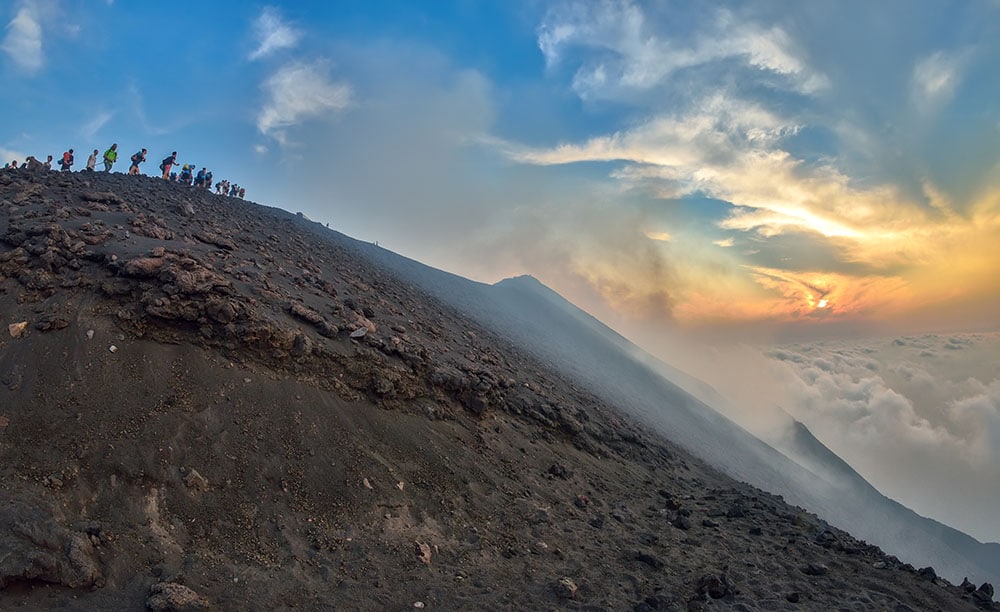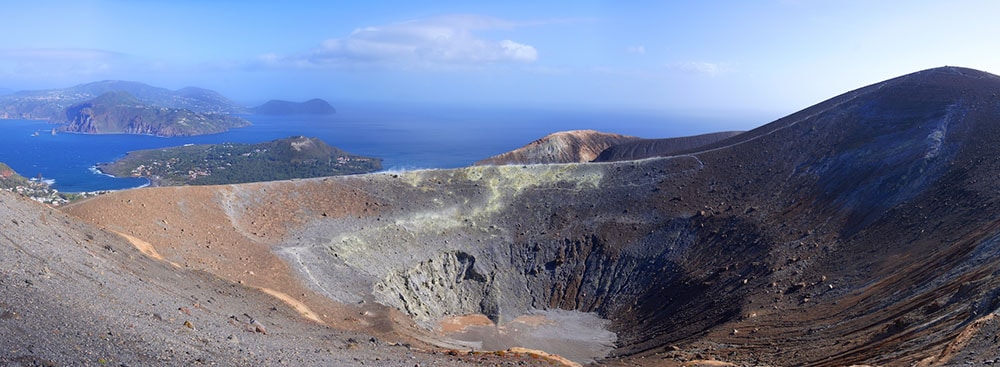
The Sicily Aeolian Islands
Swept away to the Tyrrhenian Sea, northeast of Sicily, sit a series of seven islands named after Aeolus, the ancient Greek god of the winds. From gentle beach breezes to dramatic villas atop rocky precipices, the Aeolian islands are a stunningly scenic seaside retreat.
The islands are essentially an arc of volcanoes rising right out of the sea. Each island is geologically unique, including volcanic activity, steaming fumaroles and craggy rock formations. Foot and mule trails access lush meadows of flowering capers – the islands’ emblem – as well as otherworldly craters at volcano tops.
Difficult to get to, the remote island chain is well-worth the trip. The islands are serene and not crowded. Ideal climate caters to swimming along the cobalt blue coast or trekking along cliffs. Amazing meals cap off any adventure, then an evening boat ride to a neighboring paradise for more.
Hit the trails by eight or sleep late, it’s about Futtitinni, which means ‘no worries,’ like the catchy “Lion King” song Hakuna Matata. The routine is simple: wake, nourish, hike, swim, sun, sip, dine, sleep. Repeat!! Or nothing at all – dolce far niente – the sweetness of doing nothing.
Locals are friendly, typical of southern Italians from the Messina region where life is easy, fun and often outdoors. The culturally diverse region dates to 4000 BCE with Greek, Roman, North African and English influences. Italian is the spoken language, Sicilian too, but few words capture the perfection of these islands, a protected UENSCO World Heritage Site.
Islands and Towns
Sicily is larger than the Aeolian Islands and home to Mt. Etna, Europe’s tallest active volcano. Catana, Sicily’s second biggest city, is the closest major airport to the islands. Sister city Taormina is charming with an old-world feel. Built into the steep hillside overlooking the sea, a cable car descends to the beaches. Stroll through the ‘old city’ and explore the multi-cultural history of Norman ramparts, Roman columns and Greek ruins like Teatro Greco, a 3rd Century BC amphitheater.
From Taormina, ferry to the closest Aeolian island, Vulcano, famous for its black sand beaches and sulfuric atmosphere. Lipari is the largest island with an impressive 16th Century citadel. More common Aeolian architecture consists of white-washed stone houses stacked close together with outdoor terraces, climbing grape vines and colorful terra cotta tiles.
Salina is the most fertile island with vibrant contrasting colors. Next, ferry to Panarea to visit Capo Milazzese, a village from the Bronze Age followed by exploration of coastal coves and caves. On Stromboli make the magical nighttime excursion to the active volcano. Furthest West, Filicudi and Alicudi are quaint fishing and farming islands, peaceful and very pretty.
Time to Trek

From sea to sky, each island’s volcanic hillsides are accessible by trail. Lush fields are home to wild blackberries and figs combined with arid stretches of prickly pear cactus and thistle. Island hikes are moderate. Like local mulberry jam, treks are short and sweet – and steep!
Start with the mellow hike to Vulcano’s crater including a circumnavigation of the rim. On Lipari, summit Monte Guardia, a more strenuous 7-mile trek topping out at 1,700 feet and the Cappero-Ossevatorio (Volcano Observatory).
Punta del Corvo is an 8-mile route on Panarea. This touted trek ascends to 1,400 feet and features ongoing dramatic views and exciting rocky exposure. On Stromboli, a midnight hike to the island’s active crater catches the ethereal, smoky scene of the eruption. On Salina, the green island, trails cross pastoral fields with 360-degree views to the peak of the resident volcano. Then, retrace your steps to the water’s edge for a refreshing swim, the perfect finish to every Aeolian Island trek.
Mangia! Eat!
Italy is for foodies. Aeolian Island food features fresh ingredients and age-old cooking techniques. The volcanic environment and temperate climate result in rich soil for growing. The surrounding sea is stocked with marine life. Basil, rosemary, tomatoes, eggplants, honey, nuts, nectarines and fish are all sourced locally.
Start with a European-style breakfast of crusty bread, goat cheese, apricots and espresso. Granita is a specialty, smashed-up fruit or nuts piled atop brioche for breakfast or a scoop from the gelateria for dessert.
For lunch, panini, pesto and white peaches purchased at the bottega provide for a perfecto trailside picnic or a seaside café for pane cunzato, grilled bread seasoned with olive oil, tomato and herbs.
For dinner, there’s fine dining at four-star hotels or casual home cooking at local trattorias. Dining al fresco on the patio sip a Negroni, followed by cozze alla messinese, local steamed mussels and spaghetti alla Puttanesca.
The Aeolian Islands have a strong tradition of sweets. Savory, yet intensely sugary flavors include sesamini, sesame cookies, and piparelli, crunchy cookies with almond paste. Island harvested Malvasia wine is a fruit-forward white that pairs perfectly with dessert.
Learn more about Ryder-Walker’s Sicily: Aeolian Islands trek.









Comments are closed.